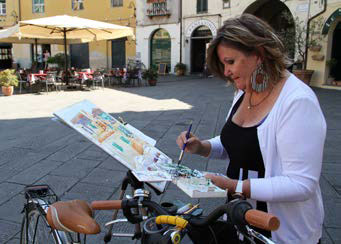|
My annual painting residency in Lucca came about by sheer luck.
Planning our well-earned holiday, we threw a dart at a map and hit
Lucca. I paid upfront for our European holiday so my workaholic
husband couldnt back out at the last minute. Theres no way hed let
any hard earned money slip through his fingers! While organising,
he said to me Why dont you stay longer and paint? So I did!
1. Finding unique opportunities: Some people ask me Why dont
you just take a photograph and paint at home! Wouldnt you have
more fun shopping? Ahhh NO!! I LOVE painting outdoors and
relish each and every opportunity. For me it is exciting and exhilarating
and frightening also it gives me a unique understanding of each
location, I feel more intimately engaged and become part of scenery
and history. Each painting session is unique successes, little disasters,
taped up fixes and all!
2. Engaging: When I paint en plein air, I am paying attention and
completely engaged; profound memories of a corner, piazza or garden,
the people, smells and sights. Painting straight from a photo
cannot match that. When I return to my studio to create another
version, all these memories come flooding back, for example, when I
cut my finger on my bicycle bell (so stupid!) and a lovely elderly couple
stopped and used their first aid kit to dress it so I could continue
painting so very kind! But I remember every angle of the buildings,
the light-struck balustrade that was so much in need of TLC, the
shapes of the shadows and the colours within.
3. Seeing value in shadows: Photographs can never do a location
justice the colours and values are never right and the shadows are
often just a black mass. On careful observation when on-site, you
will discover that shadows are never black, nor are they dull. They
are full of bounced light and luminous reflections, dark shapes and
darker corners.
4. R & D: Painting en plein air is mostly about research and development.
I create sketches, colour and value notes, so I can create larger
studio works based on the memories of each location, perfect for studio
painting in the winter months. Painting en plein can be fun but it
is also my work and a valuable asset to my professional development,
so yes, there is a certain pressure to paint, to hurry up and focus totally
which means Im not overthinking, just painting!
|

5. Taking time: Im learning to stop and smell the roses. When I
paint in Italy they think Im nuts! Im pretty much the only person
in the street when I leave home at 7am. I am a morning person and I
love early morning light!
6. Finding the focus: It is interesting that when one paints en plein
air, the focal point becomes the centre of your attention and everything
else is secondary in your visual periphery with softer edges.
This should be communicated in our paintings.
7. Connecting to people: A studio painters life can be very isolated,
tucked away behind walls and closed doors, especially in winter
months. Its great to get out and connect and share my paintings
with people, locals and visitors who appreciate art. I become part
of your history and you become part of mine. Sometimes people
stand and watch and sometimes they will ask questions or take our
picture. I am no longer a tourist, I am an artist in Italy who is respected
and supported.
8. Observing: Painting en plein air is the best training ever. There is
no better way to improve seeing and painting skills and overcome
challenges. I can observe light, shade and details and when I return
to paint in the same area, see other elements that I didnt notice or
may have been obscured by different light effects. I can walk around
and see the shapes from a different perspective and gain a deeper
understanding of my subject. I can see the origins of light and reflections
bouncing around.
9. The Masters did it! If it was good enough for the masters to paint
en plein and study the same subject over and over again, its good
enough for me. How many lily pond paintings did Monet create?
How many haystacks did van Gogh paint? More than we know Im
sure. This study leads to development of ones art and mind this is
how we grow and develop, carrying on the traditions of landscape
painters such as Corot, Monet, Ruskin, Sargent, Cezanne, Gainsborough,
Constable, Turner, Van Gogh, Renoir, Wyeth - the list is
innumerable.
10. Just being en plein air: Lastly, I love painting outdoors, I love
toting my painting gear around on my bicycle searching for my
next painting spot whether it be thru the streets of Lucca or along
the river near my home.
www.amandabrett.net
|



